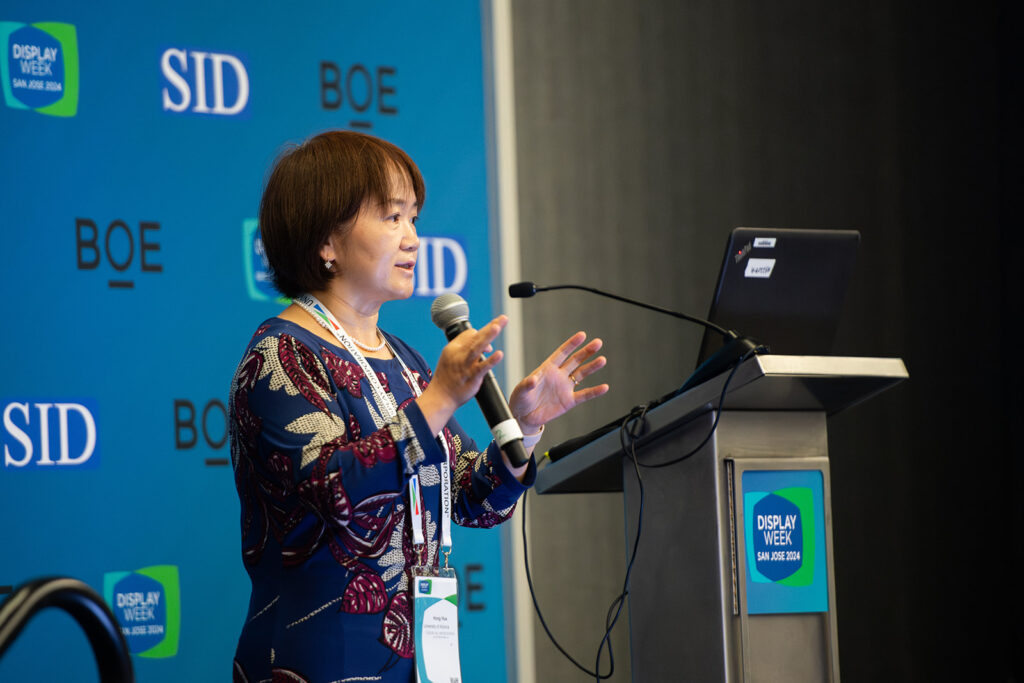Presenter Guidelines
Guidelines for SID International Symposium Speakers
Requirements for Oral Presentations at Display Week 2025
Oral presentation acceptance is subject to three conditions: (1) all company or government releases must have been obtained; (2) the paper shall be in agreement with SID copyright rules; and (3) the SID Digest material and forms must be submitted by March 15, 2025.
Illustrated text of all symposium papers will appear in the Display Week 2025 Digest of Technical Papers, both paper and electronic versions. This document enjoys a worldwide distribution that includes many scholarly libraries. Unless otherwise instructed, your paper may be included in other SID Publications or referred to in publicity releases for Display Week 2025. The Digest format allows up to four pages per paper including text and illustrations combined. Please note that the Symposium Digest of Technical Paper will not be released to the general public in any form (print, electronic, or online) until the first day of Display Week.
The deadline to submit an electronic manuscript is March 15, 2025.
Please view each of the following sections when preparing and submitting your paper.
Templates and Specifications
To help you prepare your submission, SID has developed Author Guidelines and Digest Specifications. These guidelines can be accessed at the following links:


Paper Submission and Forms and Forms
After your paper is complete, please use the instructions at the following link to submit the electronic version of your paper:
General Guidelines for Speakers
To help you deliver a presentation that matches the tradition of excellence SID is celebrated for, we’ve compiled a series of tips and best practices. Whether you’re a seasoned speaker or new to presenting, we encourage you to review these suggestions to ensure your session is as dynamic and informative as the symposium itself.
1. PREPARATION. Considerable time should be taken in the preparation of the Digest material and presentation of your talk. The two should have nothing in common but subject matter, for concise writing is one thing and clear engrossing speaking is quite another. Please do plan to allow yourself plenty of time to prepare for the specific task of making an oral presentation.
2. UPLOADING YOUR PRESENTATION. All presenters are required to upload their presentation to the main servers in the Speaker Prep Room before entering their session room. Note that there will be no accommodations made for authors to use their own computers in the session rooms.
3. SHOW UP EARLY. Plan to meet with the Session Chairman near the speakers’ platform 30 minutes before the beginning of the Session. The Chairman will have some final instructions for you and you may have some for him, and it takes time to get everyone squared away. The name of your Session Chairman is given in the letter accompanying your acceptance.
Our Top 7 Tips for Giving Great Presentations
SPEAK UP.
Address the microphone as recommended by your moderator. Speak distinctly and don’t rush your words. Above all you must be heard, and those in the rear rows do want to hear you!
BE ENTHUSIASTIC.
It’s infectious. Putting across the excitement that your paper should generate is the best way to make the audience catch fire. If you let the audience see and hear your enthusiasm for the subject, they’ll pick up on it and stay with you. Let them in on the fun!
KEEP IT SIMPLE.
Your audience came to be enlightened, not confused, to be told results, not to relive every step of your research. Avoid long mathematical developments: present in words only the highlights and the logical basis of your proof, then show the results and interpret them fully. Your research took months — or years — but what counts is the substance and significance of the end result.
LANGUAGE.
Very specialized terms and acronyms should be used sparingly and only after they have been carefully explained to the audience. Any paper delivered at SID should be intelligible to anyone else attending the symposium, even though he might not be a specialist in that particular area.
OUTLINE, PRESENT, SUMMARIZE.
The written word is permanent, and each of us reads and re-reads it at his own pace. The spoken word is transient and the speaker sets the pace. Your audience needs time to absorb each thought and can’t review what you’ve just said without missing what you’re about to say. Give your listeners a chance to keep up and reinforce your message by reviewing it with them. Begin with a brief introductory summary of your thesis that places your work in the context of familiar material. Then go through the thesis slowly and in detail, amplifying each point and explaining fully. Finally, in the last couple of minutes, summarize again, in terms of your conclusions and plans for future research.
AVOID READING YOUR PAPER… USE NOTES.
Your speaking style should be relatively informal and relaxed, compared with a written research report. An informal style is usually easiest to achieve if you speak from notes, rather than read a prepared speech where every word has been written out in advance. It is better to prepare a complete set of notes for continuing reference. Speaking from notes allows you more flexibility to adjust your talk to the mood of the audience. If you do write out your talk, avoid the condensed, formal language you would use in a written presentation. Instead of “Upon examination of the maximum characteristic shown on slide 6 it is evident that . . .”, write “Now, look at the top curve on this slide and you’ll see that . . .”. Notes should be typed with keywords underlined. No matter how full your notes, you will communicate better if you try to look at your audience more than three-quarters of the time. You can do it with practice.
REHEARSE YOUR TALK AT LEAST TWICE WITH A PRIVATE AUDIENCE.
Professional actors and politicians rehearse important speeches — so should you. Ask your rehearsal audience for suggestions and reactions, especially about pacing — they’ll be able to tell you whether you’re throwing out new ideas too quickly to be grasped or moving too slowly to maintain high‑level interest. Audio/video recording and listening to/watching yourself may also give you valuable pointers; the way you think you sound may not actually be the way you sound! Time your talk, change it to make it clearer. With enough rehearsal you will be able to abbreviate your notes or do without them altogether, and that will let you make much better contact with your audience.
Speaker registration at Display Week
All speakers are required to pay registration fees. Speaker registration forms will be emailed to you in several weeks.
Author Interviews
You are invited to participate in the SID author interviews immediately following the last session of the day of your presentation. This additional forum, pioneered by SID, provides an opportunity for relaxed discussions with your colleagues — outside the strict time constraints of the regular symposium sessions.
Use of Abstract and Technical Summary for Publicity Purposes
In the past, several technical journals have requested additional information about papers to be presented at the Symposia for press coverage purposes. We would like to accommodate these requests by providing information from your abstract and/or technical summary. If you do not want your technical summary released to the press, please contact Sierra Hollinden at mdg, A Freeman Company as soon as possible at sierra.hollinden@mdg.agency.

Display Week Logo.
Welcome speakers, co-authors, panelists, moderators, session chairs, committee members, we are excited to have you presenting at Display Week! We would like to provide you with free marketing tools to promote your session/s to YOUR contacts. With our marketing efforts and yours combined, we will be sure to fill your session seats!
Please note, all presenters (speakers, co-authors, panelists, moderators, session chairs, committee members) are required to register with SID membership.

Questions?
For questions about submissions, please contact Bill Klein by email.








